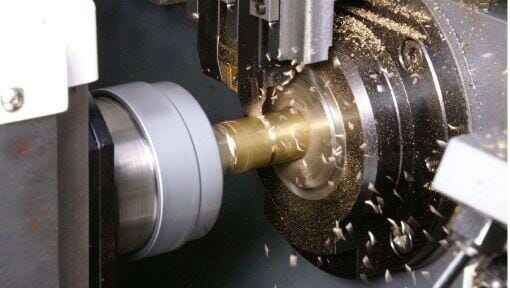The common methods of metal processing are drilling, tapping, turning, milling and broaching
There are many forms of metal cutting in production and manufacturing, such as traditional methods of sawing, shearing and blanking, as well as special methods such as laser, ultrasonic, electrochemical, high-pressure water flow and so on.
Here are four common methods:
1. Drilling — drilling and tapping
2. Turning
3. Milling
4. Broaching
Drilling is mainly divided into two steps: drilling and tapping. It is a processing method through the rotary movement of the drill bit.
The drilling process uses a tool with a spiral groove, which has a symmetrically distributed cutting edge. The cutting edge is conical, which is called the drill tip. The cuttings are removed by the rotary motion of the drill bit.
The next process of drilling is tapping, which is the cutting method of cutting with tool tap or extrusion processing. The thread is formed by removing the material on the hole wall of the previous drilling process.
1. Cutting and tapping
Cutting taps form threads by cutting metal, which will produce chips in the machining process.
2. Extrusion tapping
The extrusion tap forms a thread by squeezing the metal to the side, and there is no chip in the processing process.
Because there is more friction in the process, cutting fluid with higher lubricating performance is needed.
Turning is a machining method in which a fixed tool moves along the axial direction of a rotating workpiece
When turning, the fixed tool moves along the axial direction of the rotating workpiece, and almost any shape of the workpiece can be processed by using different tool shapes, angles and paths. The turning tool can work outside the shaft or inside the tubular part.
Milling is a machining method in which the milling cutter rotates and moves along the surface of the workpiece
Milling is a machining process using multi tooth cutters. Different from turning, when milling, the workpiece does not move, the milling cutter rotates and moves along the workpiece surface, and the plane is processed with the end face teeth of the milling cutter; Or use the circumferential teeth of the milling cutter to process the profile or groove.
Although milling and turning are similar, they have essential differences.
Milling is an intermittent processing method. Each tooth of the milling cutter contacts the workpiece for a short time, so it is easy to produce thermal fatigue and lead to tool damage.
Micro lubrication is especially suitable for milling, which can avoid the quenching effect and high-pressure impact harm caused by cutting fluid.
In addition to end milling, forming milling is divided into forwarding milling and reverse milling.
Forward milling can calculate the feed rate of each tooth, avoid the wear of work hardening on the rake face of the tool (the disadvantage of reverse milling), and the tool life is longer. Therefore, modern milling is basically based on forwarding milling.
Broaching is a machining method in which the broach moves along the surface of the workpiece
Broaching is similar to milling, except that the teeth are flattened. Compared with milling, broaching one stroke can remove all the cutting allowance.
Compared with other above processing methods, Broaching processing speed is slow and requires lubricating oil with better lubricity.
Different machining processes have different chip thickness, machining speed and machining allowance
Turning: the chips are usually continuous, the thickness of the chips is certain, and the cutting speed is medium to fast.
Milling: the machining is intermittent, the chip thickness will change, and the cutting speed will be medium to fast.
Drilling: chips are usually continuous, but the cutting speed will change.
Tapping: cutting is usually continuous, and the cutting speed is slow to medium speed.
Broaching: the chips are usually continuous, the cutting thickness of each tooth is certain, and the broaching speed is relatively low.
CONTACTS
- 0086-135 8682 0115
- 0086-574 5533 5510
67 Jinxi Road, Zhuangshi Subdistrict, Ningbo, Zhejiang, China

